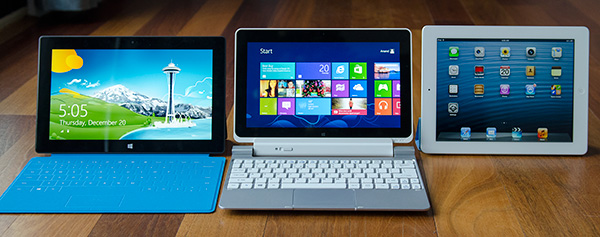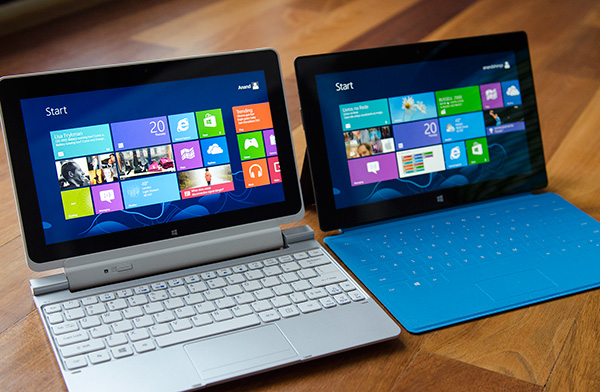The Clover Trail (Atom Z2760) Review: Acer's W510 Tested
by Anand Lal Shimpi on December 20, 2012 10:34 AM ESTFinal Words
This is a tricky conclusion to write, because as always there’s a lot of concluding that has to be done. On the one hand, we have Intel’s Clover Trail platform. On the other we have Acer’s Iconia W510 tablet itself. And on a magical third hand we have to conclude on behalf of Microsoft’s Windows 8.
I’ll start with the Intel hand.
Clover Trail is good. I only have NVIDIA’s Tegra 3 to compare it to at this point, and there Intel wins hands down. Performance is clearly better, tasks complete quicker, the modern UI is even more responsive. Power efficiency, once again, seems like a non-issue. The W510 in particular uses a smaller battery than most, but its battery life per watt-hour is very similar to Surface RT. Samsung’s ATIV Smart PC actually seems to be a better showcase of what Clover Trail can do from a power efficiency standpoint. If we haven’t squashed the notion of Intel being unable to build low power SoCs by now, Clover Trail should help drive the nail into that coffin. The debate is no longer about whether or not Intel can build something competitive with ARM on the power front, but whether Intel can execute quickly enough to defend its marketshare.
Backwards compatibility is a hit or miss advantage for Clover Trail. If you use it for the flexibility of being able to run nearly every Windows application available, then you’ll be pleased. Small apps that I’ve relied on for years just run without issue on Clover Trail. I don’t need to find modern replacements, my library of tools just work. I suspect this advantage will appeal in enterprise markets where custom applications are often on very long development cycles.
However if you’re expecting to be able to enjoy a similar experience to what you currently have on your Ultrabook, you’ll be sorely disappointed. Atom isn’t Core, the performance delta is dramatic. The Windows 8 desktop experience on Clover Trail is like using a notebook from several years ago. Performance is at least consistent thanks to the lack of any mechanical storage, but running intense workloads on the platform is hardly quick. Being quicker than most of the ARM platforms on the market today isn’t enough, Intel has to deliver a good experience across all applications. The experience is further hampered by sub-par UI performance in desktop mode. It actually feels like Tegra 3/Surface RT are faster when it comes to desktop UI performance. This highlights a disturbing trend within Intel’s ultra mobile products. The company continues to under-spec its ultra mobile GPUs. If Intel is really serious about both the tablet and smartphone markets it needs to build the best SoCs in the world, and that means delivering the best CPU and GPU performance.
I was impressed by the unique combination of closed box tablet OS and flexible/customizable desktop OS that Windows RT delivered. Windows 8 on Clover Trail takes that feeling to a completely new level. Being able to install and run nearly any weird, old application in one breath and then switch over to a fairly well optimized tablet experience in the next is pretty awesome. Where the experience falls short is really the performance of desktop mode and most of the applications I’d like to run unfortunately. Scrolling isn’t smooth, response time is pretty bad if you’re running anything demanding. You have to keep in mind that, at best, we’re talking about mainstream notebook CPU performance from around 2005. Until Intel revs Atom (which should happen next year, thankfully enough), the backwards compatibility story won’t be as awesome as it could be.
On the Acer side of things, the dock experience (particularly the troubles I had with the clickpad) also contributes to the W510 not being the perfect tablet+notebook in one. As a standalone tablet I prefer the W510, it’s got a great form factor and I love its light weight. As a docked system however, Samsung’s ATIV Smart PC seems to be the better choice.
The W510 itself is well executed, but overall the experience seemed a bit less polished than with Microsoft’s Surface RT. This is where things get really complicated. I want the SoC from the W510 but in the overall device experience that Microsoft’s Surface delivered. I even think Acer might have a form factor advantage in the W510 since it’s just so light. It’s a shame that the only x86 Surface device will be the bigger Pro model.
Ultimately my conclusion about the W510 in particular is a lot like what I felt about Surface RT. You know it’s going to be made obsolete in less than a year’s time, so you have to be ok with that fact if you’re going to pull the trigger today. Even then, the experience isn’t perfect. Microsoft still needs some updating on the Windows side to address bugs and quirks with the OS. Performance isn’t as big of a problem on the W510 as it was on Surface RT, but I’d still like to see more on that front as well.
Much of the same goes for Windows 8. Although its execution hasn’t been perfect, I really do like the OS and I see a lot of potential in these converged notebook/tablet devices. Especially for users who travel a lot, being able to have the best of both worlds in an extremely portable device is a wonderful dream. I think Microsoft has the right vision, but what we need to see are more revs to the OS to fully realize it. The real question is whether or not Microsoft will be able to deliver significant updates to Windows 8 as quickly as the market needs it.













104 Comments
View All Comments
jeffkro - Thursday, December 20, 2012 - link
Didn't we see this atom chip get bested by the arm a15 in the new chromebook? Why would any manufacturer pay more for a lower performing atom chip? Until the latest and greatest atom chip comes out towards the end of 2013 its pretty clear the high end in inexpensive low power chips is going to be held by the a15 architecture.jeffkro - Thursday, December 20, 2012 - link
I think phone and tablet devices based on the tegra 4 are going to be the gold standard for 2013.hrrmph - Thursday, December 20, 2012 - link
How about:- Tegra 4 on the phone; and
- Haswell on tablets?
mrdude - Thursday, December 20, 2012 - link
Haswell's 10W ULV chips will be priced as much as competitors' tablets. And I don't mean just the SoCs, I mean the entire tablet.I'm sure Haswell will be great, but unless you're willing to fork over >$900 for a tablet, and very few are, it's not going to fly with the public at large. What Intel needs is Bay Trail, not Haswell. By the looks of it, the A15 will be the king throughout most of 2013
semiconshawn - Friday, December 21, 2012 - link
I will willingly pay a grand or more for a tablet that rans full win8 at intel core speeds that has 256gb,8-9hrs of batt, high qual/dpi screen, and is thinner/lighter the the surface pro. I think by fall of '13 my device will be ready. Probably several to choose from. There may be an SP by then as well. Current crop looks undercooked to me.HisDivineOrder - Saturday, December 22, 2012 - link
Yes, but mrdude said explicitly, "it's not going to fly with the public at large."You might be willing to put down $1k late next year for the tablet PC of your dreams, but by then we'll likely be in a world of $100 7" tablets by Google.
$100 vs $1k? Even RT devices will probably be $300-700. Meanwhile, Windows RT offers no benefit over Android besides a useless desktop and sync'ing at the cost of sheer multitude of apps available.
I think I agree with mrdude. Not many people will fork over $1k for a tablet that is like their laptop if they can keep using their current laptop PLUS buy a new $100 tablet every year for 10 years for the same cost of that Surface Pro.
nofumble62 - Friday, December 21, 2012 - link
Tegra4 has a bunch of new graphic cores. Since it uses same 28nm process, I wonder how fast it sucks down the battery.Lonyo - Thursday, December 20, 2012 - link
Last I checked, ARM doesn't have any backwards compatibility with almost the entire library of x86 Windows applications.mayankleoboy1 - Thursday, December 20, 2012 - link
Which means nothing, as these mobile chips are too underpowered to actually run the desktop x86 applications. It will run, just so slow you will throw the device in frustration.amdwilliam1985 - Thursday, December 20, 2012 - link
It means a lot to have x86 compatible.Not everyone wants or needs to run photoshop or autocad.
But Knowing that your tablet/pc can run stuff like notepad++, chrome, java and flash is A LOT to everyday regular consumer.
My girlfriend uses both ipad and my EeePC from 2 years. Both products has its usage. But with this, she can get rid of those.